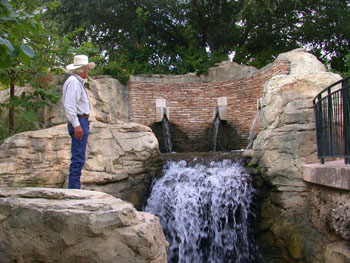Our bath tubs had to have a ring painted around at the 5" mark, and we didn't leave the water running for any reason. We didn't flush for every little pee, and we didn't water our yards. It was all for the War Effort.
Now when you have spent seven years doing that, (don't forget the war started 2 years earlier for the British), old habits die hard. I still can't abide, or understand, people wasting fresh water.
I don't know about the washing of cars, during the war, as very few had them where I lived, even though it was an affluent neighborhood, as the bus stop was close by, and neither of my grandparents drove. The London Transport System is/was supposed to be the best in the world. You could get anywhere very easily. If people did have cars, they didn't use them as the petrol rationing was very confining, and they probably gave their petrol stamps to the workers in their family.
When our subdivision in Golders Green, suburb of London, was built, everyone had wooden posts with decorative metal chain to keep folks out of their front yards. The chain was taken early on in the war to make tanks, guns, ammunition, etc. Everything was geared for the War Effort.
________________
Time-lapse video of Lake Powell drying up. http://www.youtube.com/watch?v=yzBt5CsiUEMWired Magazine has compiled a set of 10 time lapse videos of natural phenomena around the world, using NASA satellite images, including Lake Powell along the Colorado River. According to the caption, "from 2000 to 2005 its water level dropped from 20 million to 8 million acre-feet, due to severe drought. Water levels have rebounded a bit, but are expected to plummet to levels even lower than those of 2005 during the next serious drought."
A video about Lake Mead: http://news.nationalgeographic.com/news/2007/08/photogalleries/wip-week40/photo4.html
Lake Mead drying up
Lake Mead as seen from the Hoover Dam. Water levels once covered the white ring around the lake. (Photo credit unknown)
Lake Mead.
Lake Powell.
___________________________
Reuse In San Antonio: A Long History
"Few places in the United States have practiced reuse of wastewaters longer than San Antonio. As early as 1894, raw sewage was widely used in agriculture in fields south of town. By 1901, Mitchell Lake had been constructed to capture excess flows that could not be used. By the 1930s, a wastewater treatment plant had been constructed, and both raw and partially treated effluents continued to be delivered to farmlands and to Mitchell Lake through a network of ditches."
From: http://www.edwardsaquifer.net/reuse.html
“Farmers, governments, and their professional advisors, had all believed that the wells would flow forever.Discharge to the River Walk
Most visitors to San Antonio are unaware that during dry times, the famous River Walk is almost all recycled water from the city's treatment plants. This is one of the discharges, located adjacent to the Convention Center.
Indoor Water Conservation Tips:
______________
The consequences are now evident in many countries. In essence, the world has been exploiting the reserve bank of groundwater at a rate far greater than the rate of natural replacement, and the water bank is becoming insolvent.
This excess use of water is a deficit that can never be repaid in our time.”
From: http://www.larouchepub.com/other/2006/3310endersbee_water.html
______________________
This excess use of water is a deficit that can never be repaid in our time.”
From: http://www.larouchepub.com/other/2006/3310endersbee_water.html
______________________
________________
There are a number of ways to save water, and they all start with you.
More at:
#2
When washing dishes by hand, don't let the water run while rinsing. Fill one sink with wash water and the other with rinse water.
#3
Some refrigerators, air conditioners and ice-makers are cooled with wasted flows of water. Consider upgrading with air-cooled appliances for significant water savings.
#4
Adjust sprinklers so only your lawn is watered and not the house, sidewalk, or street.
#5
Run your clothes washer and dishwasher only when they are full. You can save up to 1,000 gallons a month.
http://www.wateruseitwisely.com/100-ways-to-conserve/index.php
It started out at 40 deg. on the screen porch, but I was out there about 9.30 AM wearing a t-shirt and cotton sweater, scrubbing the algae off the fence with a bucket of water, Super Clean and some Clorox.
We were supposed to pressure wash it today.

.jpg)
.jpg)

















1 comment:
Very good post today. I learned to value water when I spent 3 months+ backpacking in the Appalachians. Sometimes there was more than enough, but on the "dry" side of a mountain there were no streams and no water to be had. Of course, whatever little I had left had to be saved for the dog.
Post a Comment